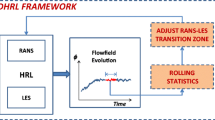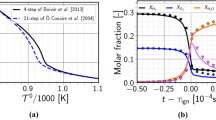Abstract
Large eddy simulations (LES) of a scramjet combustor are reported in this paper. The case under study is a cavity-based combustion chamber that is experimentally studied at the US Air Force Research Laboratory. The chamber is fed by eleven injectors. The computational domains are either simplified including only one or two injectors or complete with the 11 injectors. A good agreement is found between experimental data (velocities measured by PIV) and results from the LES if the kinetic used is chosen with care. A high temperature is found inside the cavity promoting a reactive zone located in the mixing layer where the flow velocity is high. At this location, the combustion occurs first in a diffusion dominated regime followed by the efficient burning of a well mixed mixture (rich then lean). A significant diffusion dominated burning is also found inside the cavity, mostly at the interface between the two recirculation zones. The simulation of the complete geometry revealed a transverse phenomenon on the temperature and mixing fields, but which had nevertheless little effect on the comparison with the available experimental data. A tabulation of the chemistry based on a premixed flamelet library without compressibility effects has been tested a priori on the results of the simulation with one injector. Good results on temperature and \(\hbox {H}_2\hbox {O}\) fields are found. Significant localized discrepancies appeared on CO and \(\hbox {CO}_2\) fields due to the complexity of the combustion regimes, while compressibility effects were found to be weak for the configuration studied.


































Similar content being viewed by others
References
Babkin, V., Bunev, V., Bolshova, T.: Superadiabatic temperature phenomenon in the combustion process due to a competition between chemical reactions. Combust. Explos. Shock Waves 51(2), 151–159 (2015)
Baurle, R.A.: Hybrid Reynolds-averaged/large eddy simulation of a scramjet cavity flameholder. AIAA J. 55(2), 544–560 (2017)
Bioche, K., Vervisch, L., Ribert, G.: Premixed flame–wall interaction in a narrow channel: impact of wall thermal conductivity and heat losses. J. Fluid Mech. 856, 5–35 (2018)
Bouheraoua, L., Domingo, P., Ribert, G.: Large-eddy simulation of a supersonic lifted jet flame: analysis of the turbulent flame base. Combust. Flame 179, 199–218 (2017)
Candel, S., Schmitt, T., Darabiha, N.: Progress in transcritical combustion: experimentation, modeling and simulation. In: 23rd ICDERS (2011)
Cheng, T., Wehrmeyer, J., Pitz, R., Jarrett, O., Northam, G.: Raman measurement of mixing and finite-rate chemistry in a supersonic hydrogen-air diffusion flame. Combust. Flame 99(1), 157–173 (1994)
Domingo, P., Vervisch, L., Veynante, D.: Large-eddy simulation of a lifted methane jet flame in a vitiated coflow. Combust. Flame 152(3), 415–432 (2008)
Duboc, B., Ribert, G., Domingo, P.: Description of kerosene/air combustion with hybrid transported-tabulated chemistry. Fuel 233, 146–158 (2018)
Duboc, B., Ribert, G., Domingo, P.: Evaluation of chemistry models on methane/air edge flame simulation. Proc. Combust. Inst. 37(2), 1691–1698 (2019a)
Duboc, B., Ribert, G., Domingo, P.: Hybrid transported-tabulated chemistry for partially premixed combustion. Comput. Fluids 179, 206–227 (2019b)
Fiorina, B., Gicquel, O., Vervisch, L., Carpentier, S., Darabiha, N.: Approximating the chemical structure of partially premixed and diffusion counterflow flames using FPI flamelet tabulation. Combust. Flame 140, 147–160 (2005)
Gicquel, O., Thévenin, D., Darabiha, N.: Influence of differential diffusion on super-equilibrium temperature in turbulent non-premixed hydrogen/air flames. Flow Turbul. Combust. 73, 307–321 (2004)
Gonzalez-Juez, E., Kerstein, A., Ranjan, R., Menon, S.: Advances and challenges in modeling high-speed turbulent combustion in propulsion systems. Prog. Energy Combust. Sci. 60, 26–67 (2017)
Guven, U., Ribert, G.: Large-eddy simulation of supersonic hydrogen/oxygen combustion: application to rocketlike igniter. J. Propuls. Power 34(2), 291–307 (2018)
Guven, U., Ribert, G.: Impact of non-ideal transport modeling on supercritical flow simulation. Proc. Combust. Inst. 37(3), 3255–3262 (2019)
Hassan, E., Peterson, D., Walters, K., Luke, E.: Dynamic hybrid Reynolds-averaged Navier–Stokes/large-eddy simulation of a supersonic cavity. J. Propuls. Power 32(6), 1343–1352 (2016)
Hassan, E., Peterson, D., Walters, D., Luke, E.: Dynamic hybrid Reynolds-averaged Navier–Stokes/large-eddy simulation of a supersonic cavity: chemistry effects. J. Propuls. Power 35(1), 201–212 (2019)
Kopp, M., Donato, N., Petersen, E., Metcalfe, W., Burke, S., Curran, H.: Oxidation of ethylene–air mixtures at elevated pressures, part 1: experimental results. J. Propuls. Power 30(3), 790–798 (2014)
Liu, F., Guo, H., Smallwood, G., Gülder, O.: Numerical study of the superadiabatic flame temperature phenomenon in hydrocarbon premixed flames. Proc. Combust. Inst. 29, 1543–1550 (2002)
Lodier, G., Vervisch, L., Moureau, V., Domingo, P.: Composition-space premixed flamelet solution with differential diffusion for in situ flamelet-generated manifolds. Combust. Flame 158, 2009–2016 (2011)
Luo, Z., Yoo, C.S., Richardson, E.S., Chen, J.H., Law, C.K., Lu, T.F.: Chemical explosive mode analysis for a turbulent lifted ethylene jet flame in highly-heated coflow. Combust. Flame 159(1), 265–274 (2012)
Lutz, A., Kee, R., Miller, J.: SENKIN—A Fortran program for predicting homogeneous gas phase chemical kinetics with sensitivity analysis. Technical report, Report No. SAND87-8240 UC-4, Sandia Lab (1990)
Lutz, A., Rupley, F., Kee, R., Reynolds, W., Meeks, E.: EQUIL: A CHEMKIN implementation of STANJAN for computing chemical equilibria. Technical report, Reaction Design (1998)
Meeks, E., Kee, R., Dandy, D., Coltrin, M.: Computational simulation of diamond chemical vapor deposition in premixed C$_2$H$_2$/O$_2$/H$_2$ and CH$_4$/O$_2$ strained flames. Combust. Flame 92, 144–160 (1993)
Metcalfe, W., Burke, S., Ahmed, S., Curran, H.: A hierarchical and comparative kinetic modeling study of C$_1$-C$_2$ hydrocarbon and oxygenated fuels. Int. J. Chem. Kinet. 45(10), 638–675 (2013)
Najafi-Yazdi, A., Cuenot, B., Mongeau, L.: Systematic definition of progress variables and intrinsically low-dimensional, flamelet generated manifolds for chemistry tabulation. Combust. Flame 159(3), 1197–1204 (2012)
Nguyen, P.D., Vervisch, L., Subramanian, V., Domingo, P.: Multidimensional flamelet-generated manifolds for partially premixed combustion. Combust. Flame 157, 43–61 (2010)
Niu, Y.S., Vervisch, L., Tao, P.D.: An optimization-based approach to detailed chemistry tabulation: automated progress variable definition. Combust. Flame 160(4), 776–785 (2013)
Pons, L., Darabiha, N., Candel, S., Ribert, G., Yang, V.: Mass transfer and combustion in transcritical non-premixed counterflows. Combust. Theory Model. 13, 57–81 (2008)
Pope, S.: Small scales, many species and the manifold challenges of turbulent combustion. Proc. Combust. Inst. 34(1), 1–31 (2013)
Ribert, G., Vervisch, L., Domingo, P., Niu, Y.S.: Hybrid transported-tabulated strategy to downsize detailed chemistry for numerical simulation of premixed flames. Flow Turbul. Combust. 92, 175–200 (2014)
Ribert, G., Zong, N., Yang, V., Pons, L., Darabiha, N., Candel, S.: Counterflow diffusion flames of general fluids: oxygen/hydrogen mixtures. Combust. Flame 154, 319–330 (2008)
Ruan, J.L., Domingo, P., Ribert, G.: Analysis of combustion modes in a cavity based scramjet. Combust. Flame 251, 238–251 (2020)
Saghafian, A., Shunn, L., Philips, D.A., Ham, F.: Large eddy simulations of the hifire scramjet using a compressible flamelet/progress variable approach. Proc. Combust. Inst. 35, 2163–2172 (2015a)
Saghafian, A., Terrapon, V.E., Pitsch, H.: An an efficient flamelet-based combustion model for compressible flows. Combust. Flame 162, 652–667 (2015b)
Tuttle, S.G., Carter, C.D., Hsu, K.Y.: Particle image velocimetry in an isothermal and exothermic high-speed cavity. J. Propuls. Power 30(13), 330 (2014)
van Oijen, J., Donini, A., Bastiaans, R., ten Thije Boonkkamp, J., de Goey, L.: State-of-the-art in premixed combustion modeling using flamelet generated manifolds. Prog. Energy Combust. Sci. 57, 30–74 (2016)
Wang, K., Ribert, G., Domingo, P., Vervisch, L.: Self-similar behavior and chemistry tabulation of burnt-gas diluted premixed flamelets including heat-loss. Combust. Theory Model. 14, 541–570 (2010)
Acknowledgements
Computations resources were provided by CRIANN and GENCI (Allocations 2017 and 2018-020152).
Funding
This study was funded by the French Department of Defense (DGA) (Grant Number 2015089).
Author information
Authors and Affiliations
Corresponding author
Ethics declarations
Conflict of interest
The authors declare that they have no conflict of interest.
Appendix: Progress Variable
Appendix: Progress Variable
The construction of progress variable needs to satisfy two conditions:
-
(1)
the progress variable C must be a monotonically increasing function of the physical coordinate X;
-
(2)
all tabulated quantities must be injective functions of the progress variable C.
The verification is done for \(\phi \in \left[ 0.4,5 \right]\) in Fig. 35 for (I) and in Fig. 36 for (II).
Rights and permissions
About this article
Cite this article
Ruan, J.L., Bouheraoua, L., Domingo, P. et al. Simulation of a Scramjet Combustor: A Priori Study of Thermochemistry Tabulation Techniques. Flow Turbulence Combust 106, 1241–1276 (2021). https://doi.org/10.1007/s10494-020-00184-4
Received:
Accepted:
Published:
Issue Date:
DOI: https://doi.org/10.1007/s10494-020-00184-4






